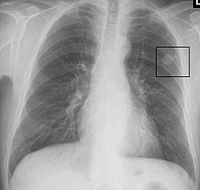
Photo from wikipedia
Background Increased uptake of fluorodeoxyglucose (FDG) by lung tissue could reflect inflammatory changes related to radiation pneumonitis (RP). In this secondary analysis of a clinical trial, we examined potential associations… Click to show full abstract
Background Increased uptake of fluorodeoxyglucose (FDG) by lung tissue could reflect inflammatory changes related to radiation pneumonitis (RP). In this secondary analysis of a clinical trial, we examined potential associations between posttreatment lung FDG uptake and RP severity in patients with non-small cell lung cancer (NSCLC) for up to 12 months after concurrent chemoradiation (CRT). Methods Subjects were 152 patients with NSCLC who had received concurrent CRT as part of the prospective trial NCT00915005. The following lung FDG variables were evaluated after CRT: maximum, mean, and peak standardized uptake values (SUVmax, SUVmean, SUVpeak) and global lung glycolysis (GLG; lung SUVmean × lung volume). RP severity was scored with the Common Terminology Criteria for Adverse Events v3.0. Results Significant associations were noted between PET findings and RP severity at 1–6 months (all P < 0.05), but not at 7–12 months after therapy (all P > 0.05). Lung FDG uptake at 1–3 months after treatment predicted later development of grade ≥2 RP (all P < 0.05), with cutoff values as follows: 4.54 for SUVmax, 3.69 for SUVpeak, 0.78 for SUVmean, and 2295 for GLG. Conclusions Lung FDG uptake correlated significantly with RP severity during the first 6 months after CRT. The cutoff values seem clinically meaningful for identifying patients at risk of developing RP after such therapy.
Journal Title: Clinical and Translational Radiation Oncology
Year Published: 2017
Link to full text (if available)
Share on Social Media: Sign Up to like & get
recommendations!